Wikipedia:Picture of the day/February 2006
|
Featured picture tools: |
These featured pictures, as scheduled below, appeared as the picture of the day (POTD) on the English Wikipedia's Main Page in February 2006.
You can add an automatically updating POTD template to your user page using {{Pic of the day}} (version with blurb) or {{POTD}} (version without blurb). For instructions on how to make custom POTD layouts, see Wikipedia:Picture of the day.
February 1 - Wed
[edit]
| |
| A skilled baseball pitcher often throws a variety of different pitches in order to prevent the batter from hitting the ball well. The most basic pitch is a fastball, where the pitcher throws the ball as hard as he can. Some pitchers are able to throw a fastball at a velocity of over 100 miles per hour (160 km/h). Other common types of pitches are the curveball, slider, changeup, forkball, and knuckleball. These generally are intended to have unusual movement to deceive the batter as to the rotation or velocity of the ball, making it more difficult to hit.
Photo credit: Rick Dikeman | |
Text version ( view - edit - talk - history ) — Condensed version ( view - edit )
February 2 - Thu
[edit]
|
The flower-flies or hover-flies are a family of flies (Diptera), scientifically termed the Syrphidae. As their name suggests, they are most often seen around flowers; the adults feed mainly on nectar and pollen, while the larvae (maggots) eat a wide range of foods. Some flower-flies, such as Volucella pellucens, mimic bees or wasps in appearance, both in shape and coloration. It is thought that this mimicry protects hover-flies from falling prey to birds and other insectivores which avoid eating true wasps because of their sting. Photo credit: PiccoloNamek |
Text version ( view - edit - talk - history ) — Condensed version ( view - edit )
February 3 - Fri
[edit]
|
The Common Hazel is a shrub native to Europe and Asia. Its flowers are produced very early in spring before the leaves, and are monoecious. The seed is a nut, known as a hazelnut or cobnut. The nut falls out of the husk when ripe, about 7-8 months after pollination. The kernel of the seed is edible and used raw or roasted, or ground into a paste. Photo credit: Fir0002 |
Text version ( view - edit - talk - history ) — Condensed version ( view - edit )
February 4 - Sat
[edit]
|
The boobies are a group of seabirds closely related to the gannets. They are large birds with long pointed wings and long bills. Boobies hunt fish by diving from a height into the sea and pursuing their prey underwater. They have facial air sacs under their skin which cushion the impact with the water. Boobies normally lay one or more chalky blue eggs on the ground or sometimes in a tree nest. Their name is based on the Spanish slang term bubi, meaning "dunce". Photo credit: United States Coast Guard |
Text version ( view - edit - talk - history ) — Condensed version ( view - edit )
Mainpage version ( view - edit )
February 5 - Sun
[edit]
|
The Domestic Sheep is the most common species of the sheep genus. It is a woolly ruminant quadruped that probably descended from the wild moufflon. Many breeds of sheep exist, generally classified as wool class breeds and hair class breeds. Farmers develop wool breeds for superior wool quantity and quality (fineness of fibers), wool staple length and degree of crimp in the fiber. Hair class sheep are the original class of sheep, developed worldwide for meat and leather. Photo credit: Fir0002 |
Text version ( view - edit - talk - history ) — Condensed version ( view - edit )
Mainpage version ( view - edit )
February 6 - Mon
[edit]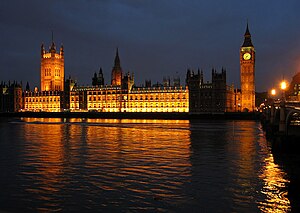
|
The Palace of Westminster occupies a site of approximately 3.24 hectares (8 acres) on the west bank of the Thames, it has approximately 1,000 rooms, 100 staircases, and 4.8 km of passageways. The 96 m high slim Clock Tower is undoubtedly the most famous feature, and houses the bell known as Big Ben, from which the Clock Tower is colloquially, but inaccurately named. Photo credit: Solipsist |
Text version ( view - edit - talk - history ) — Condensed version ( view - edit )
February 7 - Tue
[edit]
|
Dione is a moon of Saturn discovered by Giovanni Cassini in 1684. It is named after the titan Dione of Greek mythology and is also designated Saturn IV. Dione is composed primarily of water ice, but as the densest of Saturn's moons (aside from Titan, whose density is increased by gravitational compression) it must have a considerable fraction of denser material like silicate rock in its interior. Photo credit: NASA |
Text version ( view - edit - talk - history ) — Condensed version ( view - edit )
February 8 - Wed
[edit]
|
Roses are one of the most popular garden shrubs, and are also among the most common flowers sold by florists. The hips are sometimes eaten, mainly for their vitamin C content. They are usually pressed and filtered to make rose hip syrup, as the fine hairs surrounding the seeds are unpleasant to eat (resembling itching powder). Photo credit: Fir0002 |
Text version ( view - edit - talk - history ) — Condensed version ( view - edit )
February 9 - Thu
[edit]
|
The Mexican beaded lizard is a lizard found in Mexico that grows up to 18 inches in length. Along with the Gila monster, it was once thought to be one of only two lizards known to be venomous. However, recent research showed that some Iguanas and Monitors also produce venom. Their venom is similar to that of some snakes. Photo credit: PiccoloNamek |
Text version ( view - edit - talk - history ) — Condensed version ( view - edit )
February 10 - Fri
[edit]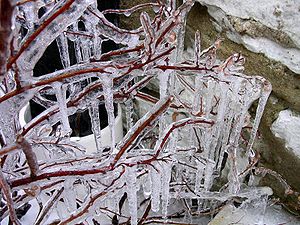
|
Liquid water is most dense at 4 °C and becomes less dense as the water molecules begin to form the hexagonal crystals of ice as the temperature drops to 0 °C. This is due to hydrogen bonds forming between the water molecules, which line up molecules less efficiently (in terms of volume) when water is frozen. The result is that ice floats on liquid water, an important factor in Earth's climate. Photo credit: Barfooz |
Text version ( view - edit - talk - history ) — Condensed version ( view - edit )
February 11 - Sat
[edit]
|
A Bessbug is a very large beetle, about 2.5 cm (1 inch) long, found in the Eastern United States and Canada, that feeds on rotting wood. It has a "horn" on the dorsal head. They are highly subsocial beetles that care for their young; they prepare food for them and help the larvae construct the pupal case. They are known to produce fourteen acoustical signals, more than many vertebrates. Photo credit: PiccoloNamek |
Text version ( view - edit - talk - history ) — Condensed version ( view - edit )
Mainpage version ( view - edit )
February 12 - Sun
[edit]
|
The Game of Life is a cellular automaton devised by John Conway. Ever since its publication in the October 1970 issue of Scientific American, it has attracted much interest because of the surprising ways the patterns can evolve. Life is an example of emergence and self-organization in the way that complex patterns, such as this example of Gosper's glider gun, can emerge from the implementation of very simple rules. Illustration credit: Kieff |
Text version ( view - edit - talk - history ) — Condensed version ( view - edit )
Mainpage version ( view - edit )
February 13 - Mon
[edit]
|
Mark Webber is an Australian Formula One driver. After rising through the ranks of motor sport, Webber made his Formula 1 debut with Minardi-Asiatech in the 2002 Australian Grand Prix, where he finished 5th. In the next season he joined Jaguar Racing (seen here in the during the 2004 United States Grand Prix), then joined the Williams-BMW team for 2005. Photo credit: Rick Dikeman |
Text version ( view - edit - talk - history ) — Condensed version ( view - edit )
February 14 - Tue
[edit]
|
Glacier retreat is a type of glacial motion in which more material ablates from its terminus of the glacier than is replenished by flow into that region. In this region of the Bhutan-Himalaya, glacial lakes have been rapidly forming on the surface of the debris-covered glaciers and researchers have found a strong correlation between increasing temperatures and glacial retreat. Photo credit: NASA & USGS |
Text version ( view - edit - talk - history ) — Condensed version ( view - edit )
February 15 - Wed
[edit]
|
The Damselfly (suborder Zygoptera) is an insect in the order Odonata. They are similar to a dragonfly, but the adults can be differentiated by the fact their wings are held along the body when at rest. They are also usually smaller, and weaker fliers than dragonflies, and the eyes are separated. Photo credit: Fir0002 |
Text version ( view - edit - talk - history ) — Condensed version ( view - edit )
February 16 - Thu
[edit]
|
Tadeusz Kościuszko was a Polish national hero, general and a leader of the Kościuszko Uprising against Russia in 1794. In this painting, he is shown taking the oath as leader of Kościuszko Uprising in Kraków market square. He also fought in the American Revolutionary War as a colonel in the Continental Army on the side of Washington. Painting credit: Wojciech Kossak |
Text version ( view - edit - talk - history ) — Condensed version ( view - edit )
February 17 - Fri
[edit]
|
The island Ko Samui has a population of about forty thousand, and survives on a successful tourist industry, as well as exports of coconut and rubber. It even has its own international airport, with flights daily to Bangkok and other major airports in Southeast Asia. It has not forgotten its roots, however, and the people are still by-and-large the same easygoing island folk they were before the world landed on their doorstep. Photo credit: Tsui |
Text version ( view - edit - talk - history ) — Condensed version ( view - edit )
February 18 - Sat
[edit]
|
The Falkirk Wheel is a rotating boat lift connecting the Forth and Clyde Canal with the Union Canal near Falkirk in central Scotland. It consists of two diametrically opposed caissons which rotate to transfer boats between the two canals through a height of 35 metres. Thanks to Archimedes' principle, the caissons always weigh the same, whether carrying up to 600 tonnes worth of canal barges, or just water. As such, the wheel is always perfectly balanced and despite its enormous mass, rotates through 180° in less than four minutes using just a few kilowatts. Photo credit: SeanMack |
Text version ( view - edit - talk - history ) — Condensed version ( view - edit )
Mainpage version ( view - edit )
February 19 - Sun
[edit]
|
Sea turtles are large, ocean-dwelling turtles. There are seven surviving species of sea turtle and all are endangered. Sea turtles are found in all the world's oceans with the exception of the Arctic Ocean, and some species travel between oceans. Sea turtles have an extraordinary sense of time and location. They are highly sensitive to the Earth's magnetic field and probably use it to navigate. Photo credit: Tokugawapants |
Text version ( view - edit - talk - history ) — Condensed version ( view - edit )
Mainpage version ( view - edit )
February 20 - Mon
[edit]
|
Lake Tanganyika is situated within the Western Rift of the Great Rift Valley and is confined by the mountainous walls of the valley. It is the largest rift lake in Africa and the second largest lake by surface area on the continent. It is the deepest lake in Africa and holds the greatest volume of fresh water. Photo credit: Worldtraveller |
Text version ( view - edit - talk - history ) — Condensed version ( view - edit )
February 21 - Tue
[edit]
|
Primary production is the production of biological organic compounds from inorganic materials through photosynthesis or chemosynthesis. Organisms that can create biomass in this manner (notably plants) are known as primary producers, and form the basis of the food chain. In oceanography and limnology the primary producers in aquatic environments are phytoplankton utilizing energy from sunlight. Photo credit: SeaWiFS Project, NASA |
Text version ( view - edit - talk - history ) — Condensed version ( view - edit )
February 22 - Wed
[edit]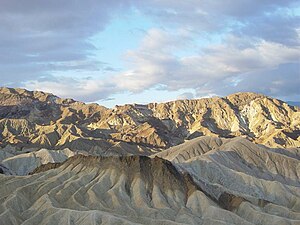
|
Zabriskie Point is an area in Death Valley National Park noted for its beautiful erosional landscape. It is called a badlands due to its difficult-to-traverse topography. The area is composed of sediment from Lake Zabriskie, which dried-up 9 million years ago - long before Death Valley existed. Zabriskie Point is named after Christian Brevoort Zabriskie of Wyoming Territory. Photo credit: Daniel Mayer |
Text version ( view - edit - talk - history ) — Condensed version ( view - edit )
February 23 - Thu
[edit]
|
Khalifa (خليفة ẖalīfä) is Arabic for "stewardship" of nature and family, and is a key obligation of a Muslim. The word is most commonly used for the Islamic leader of the Ummah, which is translated into English as Caliph. While Sunni and Shia Islam differ sharply on the conduct of a caliph and the right relations between a leader and a community, they do not differ on the underlying theory of stewardship. Photo credit: G. Eric and Edith Matson Photograph Collection |
Text version ( view - edit - talk - history ) — Condensed version ( view - edit )
February 24 - Fri
[edit]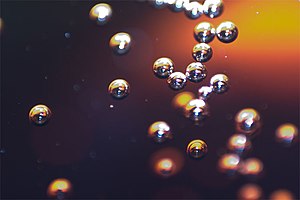
|
Historically, the first soda waters were prepared by adding sodium bicarbonate to lemonade. A chemical reaction between sodium bicarbonate and citric acid occurred to create carbon dioxide. The person who is usually credited with first successfully creating carbonated water is Joseph Priestley in 1796. Photo credit: Spiff |
Text version ( view - edit - talk - history ) — Condensed version ( view - edit )
February 25 - Sat
[edit]
|
The State Library of Victoria is the central library of the state of Victoria, Australia, located in the city of Melbourne. The Library's combined collections contain over 1.5 million books and 16,000 serials, including the diaries of the city's founders, John Batman and John Pascoe Fawkner, as well as the folios of Captain James Cook Photo credit: Diliff |
Text version ( view - edit - talk - history ) — Condensed version ( view - edit )
Mainpage version ( view - edit )
February 26 - Sun
[edit]
|
A low pressure area is a region where the atmospheric pressure is lowest with relation to the surrounding area. Air will tend to flow in to fill a low pressure area, but will be deflected perpendicular to its velocity by the Coriolis effect. A system of equilibrium can then establish itself creating circular movement, or a cyclonic flow. Photo credit: NASA |
Text version ( view - edit - talk - history ) — Condensed version ( view - edit )
Mainpage version ( view - edit )
February 27 - Mon
[edit]
|
Although used occasionally in later experimental devices, this nuclear weapon design was used only once as a weapon, in Little Boy, because of the extreme danger of a misfire. A simple crash could drive the "bullet" into the "target" and release lethal radiation doses or even a full nuclear detonation. Illustration credit: Fastfission |
Text version ( view - edit - talk - history ) — Condensed version ( view - edit )
February 28 - Tue
[edit]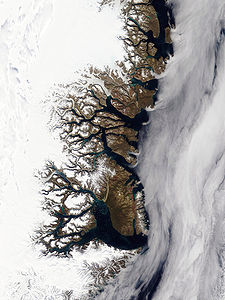
|
In English usage a fjord is a narrow inlet of the sea between cliffs or steep slopes, which results from marine inundation of a glaciated valley. Fjords are found in locations where current or past glaciation extended below current sea level. The fractal coastline of eastern Greenland, seen here, has many fjords. At the bottom is the longest fjord in the world, Scoresby Sund. Photo credit: NASA |
Text version ( view - edit - talk - history ) — Condensed version ( view - edit )
Picture of the day archives and future dates
